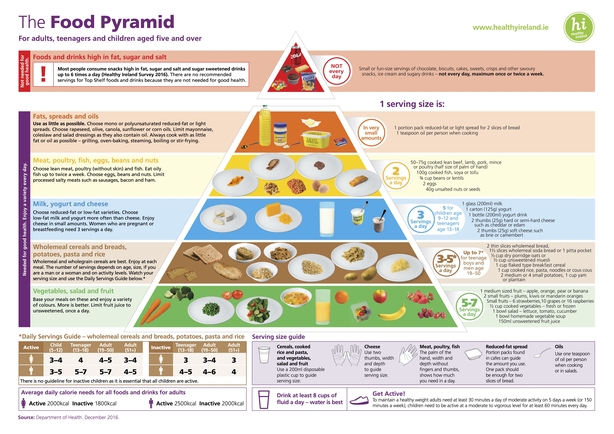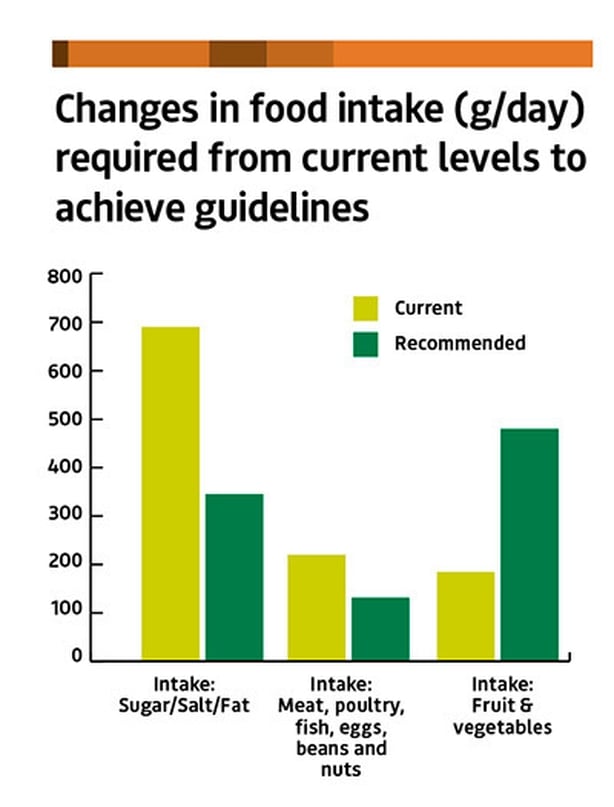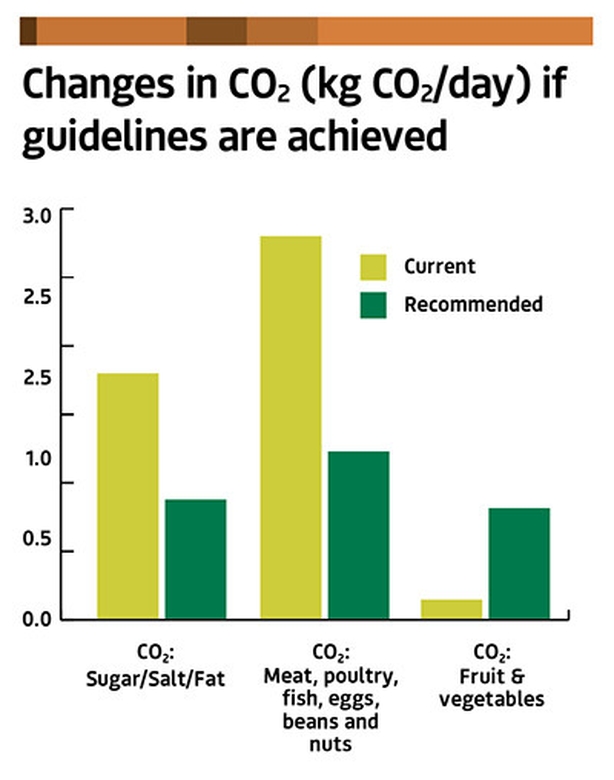Analysis: achievable changes to the familiar foods we consume would represent a 25% reduction in emissions from our current eating patterns
By Marie Conway and Sinéad McCarthy, Teagasc
The foods we eat influence our health, meaning we need to eat a balanced diet to meet nutritional needs. Healthy eating guidelines outline the types and amounts of foods to consume for a healthy, nutritional diet, and have been developed for over 100 countries globally. The basic message communicated through these guidelines is the same across the world, recommending higher consumption of fruit and vegetables, and minimum consumption of calorie-dense and nutrient-poor foods. When food consumption is not aligned with healthy eating guidelines, the risk increases for many health conditions such as heart disease, diabetes, and obesity.
In Ireland, healthy eating guidelines take the form of the food pyramid.The food pyramid comprises five shelves of different food types needed for good health, plus an additional sixth and smallest shelf at the top containing foods high in sugar/fat/salt, which are not required for good health.
When the food pyramid was first developed 30 years ago, acid rain and air pollution were the environmental concerns of the day and the link between food consumption and carbon footprint had not yet become mainstream. However, we are now faced with the added complexity of the environmental impact of food production and consumption on the planet because food production involves land and water use for growing and producing food, resulting in environmental emissions.
We need your consent to load this rte-player contentWe use rte-player to manage extra content that can set cookies on your device and collect data about your activity. Please review their details and accept them to load the content.Manage Preferences
From RTÉ Radio 1's Countrywide, Teagasc's Dr Sinéad McCarthy on what a sustainable diet looks like
Hence, the link between food consumption, health and environmental impact needs to be considered in the development of environmentally friendly healthy eating guidelines to ensure that both personal and planetary health can be achieved. This is known as a "sustainable diet". The most widely used definition of a sustainable diet is from the Food and Agricultural Organisation of the UN. They define a sustainable diet as one with low environmental impacts, which also contributes to food and nutrition security as well as a healthy life for present and future generations. These diets should also be protective of biodiversity, culturally acceptable, and economically fair.
Data from the National Adult Nutrition Survey has previously been used to determine the food consumption and environmental impact of the foods consumed by the Irish population in terms of greenhouse gas emissions (also known as carbon footprint). The carbon footprint of a food reflects the emissions associated with that food from production to consumption, and is measured in kilograms of carbon dioxide per day (kgCO2/day). It was previously shown that the foods consumed by the average adult in Ireland generates 6.5kgCO2/day.
As a part of all-island research project SuHe Guide, our current food consumption patterns were analysed using the same food consumption data, to determine the extent to which the population is meeting current healthy eating guidelines. This was then modelled to determine the changes in food consumption required to achieve guidelines, and showed that these changes would result in a more sustainable diet, with both health and environmental benefits.

Starting at the bottom of the food pyramid is fruit and vegetables, which is the most important shelf and the foundation on which our diets should be based. The recommendation is to consume at least five portions of fruit and vegetables a day, and ideally seven portions. However, intakes of fruit and vegetables were too low with the majority of people consuming just over two portions per day. The emissions associated with current fruit and vegetable consumption is low at approximately 0.15kgCO2/day.
Food consumption for cereal/starchy foods and dairy was aligned with recommended intakes and the guideline for each of these shelves was achieved. The emissions associated with the cereal/starchy foods and dairy food groups were 0.65kgCO2/day and 0.73kgCO2/day respectively.
Moving up the pyramid, foods from the protein shelf include meat, poultry, fish and legumes. Meat was consumed in excess of recommendations by approximately 90g per day. Consumption of foods from the protein shelf generates emissions of approximately 2.8kgCO2/day.
We need your consent to load this comcast-player contentWe use comcast-player to manage extra content that can set cookies on your device and collect data about your activity. Please review their details and accept them to load the content.Manage Preferences
From RTÉ's What Planet Are You On, UCD's Dr Aifric O'Sullivan on how our food generates greenhouse gases
Foods high in sugar/salt/fat, or treat foods, were eaten in amounts far exceeding the recommendation to consume sparingly and no more than twice per week. Currently, average daily consumption of these foods is approximately 690g per day, generating emissions of 1.8kgCO2/day.
We need your consent to load this Datawrapper contentWe use Datawrapper to manage extra content that can set cookies on your device and collect data about your activity. Please review their details and accept them to load the content.Manage Preferences
Changes to current food consumption, especially fruit and vegetables, meat, and treats, are needed to achieve healthy eating guidelines. Our current treat consumption should be at least halved. While this would not meet the guidelines in the food pyramid, it would be an achievable reduction with resultant benefits for health and reduced GHG emissions. If treat foods were swapped for three portions of fruit and vegetables, alongside a reduction in meat intake by one portion per day, the healthiness of our diets could be increased, while simultaneously bringing a substantial daily reduction in emissions of 1.6kgCO2/day.


These moderate and achievable changes to the familiar foods we consume would represent a 25% reduction in emissions from current eating patterns. Therefore, a simple rebalance of what we currently consume to align with healthy eating guidelines will meet the dual challenge of personal and planetary health for sustainable diets.
The SuHe Guide project is a collaborative research project including Queen’s University Belfast, UCD and UCC. This is funded through the Department of Agriculture, Food and the Marine, Food Institutional Research Measure and the Department of Agriculture, Environment and Rural Affairs.
Dr Marie Conway is a post-doctoral research officer at the Teagasc Food Research Centre and manager of the SuHe Guide project. Dr Sinéad McCarthy is a Senior Research Officer with a focus on consumer behaviour in relation to food, health and sustainability at the Teagasc Food Research Centre and is principal investigator for of the SuHe Guide project.
The views expressed here are those of the author and do not represent or reflect the views of RTÉ

